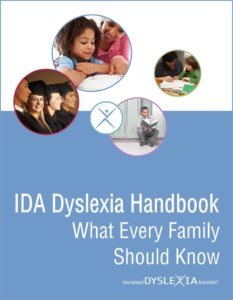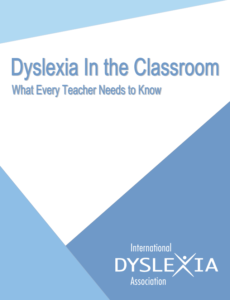
The Definition
Dyslexia is a specific learning disability that is neurological in origin. It is characterized by difficulties with accurate and/or fluent word recognition and by poor spelling and decoding abilities. These difficulties typically result from a deficit in the phonological component of language that is often unexpected in relation to other cognitive abilities and the provision of effective classroom instruction. Secondary consequences may include problems in reading comprehension and reduced reading experience that can impede the growth of vocabulary and background knowledge.
– Learn more about how consensus was reached on this definition: Definition Consensus Project.
What does that mean exactly?
- Dyslexia is a neurological difference in the brain, and it occurs in people of all backgrounds, races, and genders. Most people with dyslexia have been found to have problems with identifying the separate speech sounds within a word and learning how letters represent those sounds. This difficulty becomes a key factor in their reading difficulties.
- Dyslexia is commonly referred to as a “hidden disability”. Dyslexia is often not diagnosed/identified, which may amplify emotions of anxiety, frustration, poor self-image, and depression.
- Dyslexia runs in families, so having a parent or sibling with dyslexia increases the probability that you will also have dyslexia. For some people, their dyslexia is identified early in their lives, but for others, their dyslexia goes unidentified.
What does Dyslexia look like?
Some of the common signs of dyslexia in children…
- has creative ideas, but struggles to put them into writing
- able to read, but it is labored, and it takes a long time
- has great difficulty sounding out new/unknown words
- works so hard to study for a spelling test, but cannot retain the words the following week
- is behind grade level in reading and/or spelling
- takes a very long time to handwrite, even when copying
- dreads going to school
- has difficulty speaking when trying to find the right words; says “thingies” or “whatever-you-call-it”
- struggled to create rhymes
- confuses left and right
- took a long time to learn to tie shoes or can’t yet
- has one or both parents who struggled in school
- cannot memorize simple things like addresses, phone numbers, and basic math facts
If several of the above sound familiar…they may be signs of dyslexia. Take the steps to learn more!
Characteristics of Dyslexia Change Over Time
 |
Preschool Years
© Sally Shaywitz, Overcoming Dyslexia, p. 122 |
 |
Elementary School Years
© Sally Shaywitz, Overcoming Dyslexia, pp. 122 – 123 |
 |
Middle School Years
As elementary grades progress through middle school, students with dyslexia typically read at a slower rate than their peers and have trouble reading multi-syllable words and words with affixes. Spelling and writing weaknesses likely persist, as well as difficulty with independent reading comprehension.
|
 |
High School Years
High school students with dyslexia may continue to have word-level reading inaccuracies and typically continue to read at a slow rate. Spelling, writing, and reading comprehension difficulties may persist. |
Key Facts About Dyslexia
- Dyslexia is very common; up to 20% of people have symptoms of dyslexia.
- An unexpected struggle learning to read and write is the hallmark of dyslexia.
- Dyslexia is not caused by laziness, inattention, poor vision, low intelligence, or social/emotional problems. However, the frustration of failing to learn basic skills can cause emotional problems.
- Specialized remedial teaching in basic skills can be effective at all ages.
- ADHD (Attention deficit hyperactive disorder) may be present, but it does not cause dyslexia.
- Some people with dyslexia may be eligible for accommodations in school, exams, college, professional schools, and work.
Common Myths
- It is a myth that individuals with dyslexia read or see “backward”; dyslexia is not a vision problem.
- The difficulty with reading and spelling is not because they are not trying hard enough.
- Dyslexia is not a disease, and therefore there is no cure.
- Individuals with dyslexia do not have a lower level of intelligence.
Helpful Resources

IDA Dyslexia Handbook: What Every Family Should Know
Frequently Asked Questions
Here are some other Frequently Asked Questions about Dyslexia:
- What is the definition of dyslexia?
- What is a learning disability?
- What are some common signs of learning disabilities?
- What is a “multisensory structured language approach”?
- What is phonology and phonological awareness?
- What is sound-symbol association?
- What is syllable instruction?
- What is morphology?
- What is syntax?
- What is semantics?
- What is dyscalculia?
- What is dysgraphia?
- What is dyspraxia?
- What are auditory and visual processing disabilities?
- What if I see the signs of a learning disability?
- What can I do as a parent?
- What professionals can provide help?
- Are learning disabilities real?
- Aren’t people with learning disabilities just slow?
- Aren’t schools lowering their standards to accommodate children with learning disabilities?
- Isn’t it true that only boys have learning disabilities?
- Isn’t it dyslexia when a person inverts letters and numbers?
- Can a person with dyslexia really learn how to read?
- How can you tell if a child has a learning disability?
What is the definition of dyslexia?
“Dyslexia” Research Definition
Adopted by IDA Board, November 2002
Adopted by the National Institutes of Health, 2002
Dyslexia is a specific learning disability that is neurological in origin. It is characterized by difficulties with accurate and / or fluent word recognition and by poor spelling and decoding abilities. These difficulties typically result from a deficit in the phonological component of language that is often unexpected in relation to other cognitive abilities and the provision of effective classroom instruction. Secondary consequences may include problems in reading comprehension and reduced reading experience that can impede growth of vocabulary and background knowledge.
What is a learning disability?
The term “learning disability” describes a neurobiological disorder in which a person’s brain works or is structured differently. These differences interfere with a person’s ability to think and remember. Learning disabilities can affect a person’s ability to speak, listen, read, write, spell, reason, recall, organize information, and do mathematics.
Because learning disabilities cannot be seen, they often go undetected. Recognizing a learning disability is even more difficult because the severity and characteristics vary.
A learning disability can’t be cured or fixed; it is a lifelong issue. With the right support and intervention, however, children with learning disabilities can succeed in school and go on to successful, often distinguished careers later in life. Parents can help children with learning disabilities achieve such success by encouraging their strengths, knowing their weaknesses, understanding the educational system, working with professionals and learning about strategies for dealing with specific difficulties.
Facts about learning disabilities:
- Fifteen percent of the US population, or one in seven Americans, has some type of learning disability, according to the National Institutes of Health.
- Difficulty with basic reading and language skills are the most common learning disabilities. As many as 80% of students with learning disabilities have reading problems.
- Learning disabilities often run in families.
- Learning disabilities should NOT be confused with other disabilities such as mental retardation, autism, deafness, blindness, and behavioral disorders. NONE of these conditions are learning disabilities. In addition, they should not be confused with lack of educational opportunities like frequent changes of schools or attendance problems. Also, children who are learning English do not necessarily have a learning disability.
- Attention disorders, such as Attention Deficit / Hyperactivity Disorder (ADHD) and learning disabilities often occur at the same time, but the two disorders are not the same.
What are some common signs of learning disabilities?
PRESCHOOL
- Speaks later than most children
- Pronunciation problems
- Slow vocabulary growth, often unable to find the right word
- Difficulty rhyming words
- Trouble learning numbers, alphabet, days of the week, colors, shapes
- Extremely restless and easily distracted
- Trouble interacting with peers
- Difficulty following directions or routines
- Fine motor skills slow to develop
GRADES K-4
- Slow to learn the connection between letters and sounds
- Confuses basic words (run, eat, want)
- Makes consistent reading and spelling errors including letter reversals (b / d), inversions (m / w), transpositions (felt / left), and substitutions (house / home)
- Transposes number sequences and confuses arithmetic signs (+, -, x, /, =)
- Slow to remember facts
- Slow to learn new skills, relies heavily on memorization
- Impulsive, difficulty planning
- Unstable pencil grip
- Trouble learning about time
- Poor coordination, unaware of physical surroudings, prone to accidents
GRADES 5-8
- Reverses letter sequences (soiled / solid, left / felt)
- Slow to learn prefixes, suffixes, root words, and other spelling strategies
- Avoids reading aloud
- Trouble with word problems
- Difficulty with handwriting
- Awkward, fist-like, or tight pencil grip
- Avoids writing compositions
- Slow or poor recall of facts
- Difficulty making friends
- Trouble understanding body language and facial expressions
HIGH SCHOOL STUDENTS, AND ADULTS
- Continues to spell incorrectly, frequently spells the same word differently in a single piece of writing
- Avoids reading and writing tasks
- Trouble summarizing
- Trouble with open-ended questions on tests
- Weak memory skills
- Difficulty adjusting to new settings
- Works slowly
- Poor grasp of abstract concepts
- Either pays too little attention to details, or focuses on them too much
- Misreads information
The good news about learning disabilities is that scientists are learning more every day. Their research provides hope and direction.
If parents, teachers, and other professionals discover a child’s learning disability early and provide the right kind of help, it can give the child a chance to develop skills needed to lead a successful and productive life.
A recent National Institutes of Health study showed that 67% of young students who were at risk for reading difficulties became average or above average readers after receiving help in the early grades.
Parents are often the first to notice that “something doesn’t seem right.” If you are aware of the common signs of learning disabilities, you will be able to recognize potential problems early.
Most people will, from time to time, see one or more of the warning signs in their children. This is normal. If, however, you see several of these characteristics over a long period of time, consider the possibility of a learning disability.
Source: Coordinated Campaign for Learning Disabilities.
What is a “multisensory structured language approach”?
Principles of instruction include:
- Simultaneous and Multisensory (VAKT) – Teaching is done using all learning pathways in the brain (visual/auditory, kinesthetic/tactile) simultaneously in order to enhance memory and learning.
- Systematic and Cumulative – Multisensory language instruction requires that the organization of material follows the logical order of the language. The sequence must begin with the easiest and most basic elements and progress methodically to more difficult material. Each step must also be based on those already learned. Concepts taught must be systematically reviewed to strengthen memory.
- Direct Instruction – The inferential learning of any concept cannot be taken for granted. Multisensory language instruction requires the direct teaching of all concepts with continuous student-teacher interaction.
- Diagnostic Teaching – The teacher must be adept at prescriptive or individualized teaching. The teaching plan is based on careful and continuous assessment of the individual’s needs. The content presented must be mastered to the degree of automaticity.
- Synthetic and Analytic Instruction – Multisensory, structured language programs include both synthetic and analytic instruction. Synthetic instruction presents the parts of the language and then teaches how the parts work together to form a whole. Analytic instruction presents the whole and teaches how this can be broken down into its component parts.
What is phonology and phonological awareness?
Phonology is the study of sounds and how they work within their environment. A phoneme is the smallest unit of sound in a given language that can be recognized as being distinct from other sounds in the language.
Phonological awareness is the understanding of the internal linguistic structure of words. An important aspect of phonological awareness is phonemic awareness, or the ability to segment words into their component sounds.
What is sound-symbol association?
This is the knowledge of the various sounds in the English language and their correspondence to the letters and combinations of letters which represent those sounds. Sound-symbol association must be taught (and mastered) in two directions: visual to auditory and auditory to visual. Additionally, students must master the blending of sounds and letters into words as well as the segmenting of whole words into the individual sounds.
A syllable is a unit of oral or written language with one vowel sound. Instruction must include teaching of the six basic syllable types in the English language: closed, vowel-consonant-e, open, consonant-le, r-controlled, and diphthong. Syllable division rules must be directly taught in relation to word structure.
Morphology is the study of how morphemes are combined to form words. A morpheme is the smallest unit of meaning in the language. The curriculum must include the study of base words, roots, prefixes, and suffixes.
Syntax is the set of principles that dictate the sequence and function of words in a sentence in order to convey meaning. This includes grammar, sentence variation, and the mechanics of language.
Semantics is that aspect of language concerned with meaning. The curriculum (from the beginning) must include instruction in the comprehension of written language.
A mathematical disability in which a person has a difficult time solving arithmetic problems and grasping math concepts.
While many people have trouble with math, a person with dyscalculia has a much more difficult time than his or her peers.
A writing disability in which a person finds it hard to form letters or write within a defined space.
People with this disorder need extra time and effort to write neatly. Despite their work, their handwriting may be almost illegible.
A disorder that interferes with a person’s ability to move smoothly or to make a controlled or coordinated physical response in a given situation.
What are auditory and visual processing disabilities?
These are sensory disabilities in which a person has difficulty understanding language despite normal hearing and vision.
What if I see the signs of a learning disability?
- Know your child’s strengths
- Collect information about your child’s performance
- Have your child evaluated
- Work as a team to help your child
- Talk to your child about learning disabilities
- Find accommodations that can help
- Monitor your child’s progress
- Know your legal rights
STRATEGIES
Organize information about your child’s learning disability:
- Start a folder of all letters and materials related to your child’s education
- Add copies of school files and names and dates of all tests and results, including medical exams and information from other professionals
- Collect samples of schoolwork that demonstrate your child’s difficulties, as well as strengths
- Keep a contact log of discussions with professionals
- Keep a log of your own observations
- Work with your child at home
- Join with others who care
- Work with professionals
STRATEGIES
Helping with homework:
- Show an interest in your child’s homework. Inquire about the subjects and the work to be done. Ask questions that require answers longer than one or two words.
- Help your child organize homework materials before beginning.
- Establish a regular time with your child to do homework–developing a schedule helps avoid procrastination.
- Find a specific place for your child to do homework that has lots of light, quiet, and plenty of work space.
- Encourage your child to ask questions and search for answers, taking the time to figure out correct answers.
- Make sure your child backs up answers with facts and evidence.
- Practice school-taught skills at home.
- Relate homework to your child’s everyday life. For instance, teach fractions and measurements as you prepare a favorite food together.
- Be a role model–take the opportunity to read a book or newspaper or write a letter while your child studies.
- Praise your child for both the small steps and big leaps in the right direction.
What professionals can provide help?
There are many trained professionals who can help your child. Ask your child’s teacher or a resource consultant for names of individuals who can help, and check the RESOURCES section of this website for additional information.
AUDIOLOGIST – measures hearing ability and provides services for auditory training; offers advice on hearing aids.
EDUCATIONAL CONSULTANT – gives educational evaluations; familiar with school curriculum but may have a background in special education issues.
EDUCATIONAL THERAPIST – develops and runs programs for learning and behavior problems.
LEARNING DISABILITIES SPECIALIST – a teacher with specific training and credentials to provide educational services to students with learning disabilities and their teachers.
NEUROLOGIST – looks for possible damage to brain functions (medical doctor).
OCCUPATIONAL THERAPIST – helps improve motor and sensory functions to increase the ability to perform daily tasks.
PEDIATRICIAN – provides medical services to infants, children, and adolescents; trained in overall growth and development including motor, sensory, and behavioral development (medical doctor).
PSYCHIATRIST – diagnoses and treats severe behavioral and emotional problems and may prescribe medications (medical doctor).
PSYCHOLOGIST (clinical) – provides psychological and intellectual assessment and treatment for mental and emotional health.
SCHOOL / EDUCATIONAL PSYCHOLOGIST – gives and interprets psychological and educational tests; assists with behavior management; provides counseling; consults with parents, staff, and community agencies about educational issues.
SPEECH / LANGUAGE THERAPIST – helps children with language and speech difficulties.
Are learning disabilities real?
Yes. Learning disabilities are real, physical disorders. They result from neurobiological differences in brain structure and/or function. These differences lead to problems with learning. New brain scanning techniques enable scientists to see that there are differences in the brains of children with learning disabilities.
Aren’t people with learning disabilities just slow?
No. People with learning disabilities are just as intelligent as other people and have difficulty learning because their minds process words or information differently. Far from being lazy, they often have to work a lot harder than their peers.
Aren’t schools lowering their standards to accommodate children with learning disabilities?
No. People with learning disabilities can learn strategies to achieve as much as other people if given the proper tools, just as other students may need corrective lenses, hearing aids, wheelchairs, etc.
Isn’t it true that only boys have learning disabilities?
No. This is a common misperception. Just as many girls as boys have a learning disability and should have equal access to screening and intervention programs. In addition, learning disabilities often run in families and the genetic basis of dyslexia has been confirmed.
Isn’t it dyslexia when a person inverts letters and numbers?
This is a common misperception. Dyslexia is a language processing problem that causes people to have trouble understanding words, sentences or paragraphs. Dyslexia, or reading disability, is the most common learning disability, affecting about 80% of children who receive special education.
Can a person with dyslexia really learn how to read?
Yes, for 85% to 90% of poor readers, prevention and early intervention programs that combine instruction by well-trained teachers in phonemic awareness, phonics spelling, reading fluency and reading comprehension strategies can increase reading skills to average levels.
How can you tell if a child has a learning disability?
A 15-minute test for kindergartners or first graders can predict with 92% accuracy whether a child will have difficulty learning to read. Early diagnosis of a child’s learning disability and timely intervention by parents, teachers or doctors can greatly improve his or her self-esteem, academic achievement, and ability to form and maintain relationships. Parents and guardians should familiarize themselves with the warning signs of learning disabilities and the common characteristics of children with learning disabilities.


